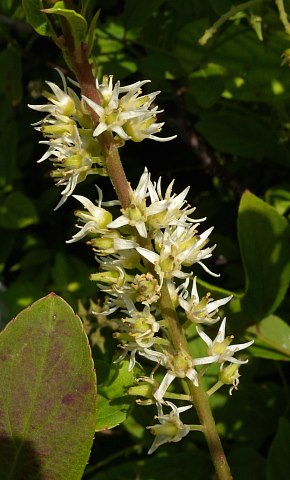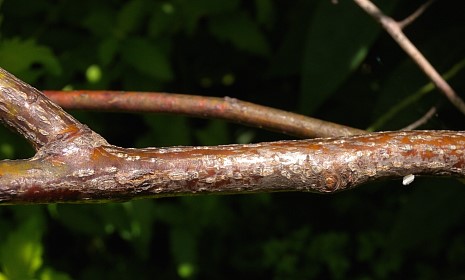
Each flower spans about 1/3" (8 mm.) across, consisting of a short open calyx with 5 shallow teeth, 5 white petals that are linear-lanceolate, 5 stamens, and a lanceoloid pistil with a single style. The calyx is light green to yellowish green and pubescent, while the pistil is yellowish green to white and pubescent. The pedicels are about 1/8" (3 mm.) long, light green or yellowish green, and short-pubescent. The central rachis of the raceme is light green to brown and pubescent. The blooming period occurs from late spring to early summer, lasting about 3-4 weeks. The flowers are mildly to moderately fragrant. Afterwards, the flowers are replaced by 2-celled seed capsules about ¼" long that are lanceoloid in shape and become dark brown at maturity. The base of each capsule is swollen by the persistent calyx. At this time, the seed capsules split open to release their seeds. The chunky seeds are 1.0-1.5 mm. long, 0.5-1.0 mm. across, and compressed (somewhat flattened). The seed surface is dark and shiny. The root system is woody and develops underground runners, forming clonal offsets. The leaves are deciduous in Illinois, becoming bright red during the autumn (see photo of Autumn Leaves).
Cultivation: The preference is partial sun, wet conditions, and soil that is muddy, silty, or sandy. Shallow standing water is tolerated. This shrub has few problems with insects or disease. Winter temperatures below -20°F can be fatal. This wetland shrub can be used along rivers to reduce soil erosion.

Range & Habitat: The native Virginia Sweetspire occurs in southern Illinois, where it is uncommon (see Distribution Map). Elsewhere in the state, this shrub is absent, except as a cultivated plant. Illinois lies along the northern range limit of this species. Habitats consist primarily of floodplain woodlands, margins of rivers and lakes, and swamps. With the notable exceptions of Bald Cypress (Taxodium distichum) and Water Tupelo (Nyssa aquatica), this shrub colonizes areas that are too wet for most trees.
Faunal Associations: At the present time, very little information about floral-faunal relationships is available. The flowers are probably cross-pollinated by bees, butterflies, and other insects. When this shrub forms colonies, it provides nesting habitat for birds and protective cover for both birds and other kinds of wildlife.

Photographic Location: A garden at the Arboretum of the University of Illinois in Urbana, Illinois.
Comments: Other common names of this shrub include Virginia Willow and Tassel-White. In addition to the Escallonia family (Mohlenbrock, 2008), this shrub is sometimes assigned to the Gooseberry family (Grossulariaceae) and the Sweetspire family (Iteaceae). There are no other Itea spp. (Sweetspire species) in North America. The closest relatives of this shrub are located in East Asia. In Illinois, Virginia Sweetspire is quite distinct, but it can be confused with other shrubs in the southeastern United States. An example of a similar-appearing shrub is Clethra alnifolia (Sweet Pepperbush). This latter species can be distinguished by its flowers, which have 10 stamens instead of 5, and by the golden yellow color of its leaves during the autumn.